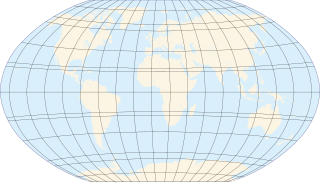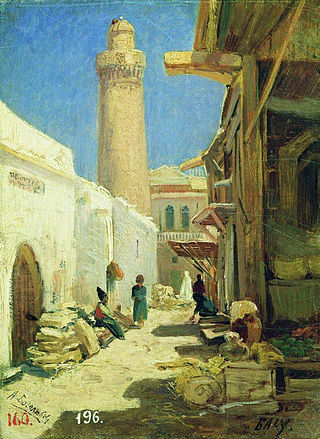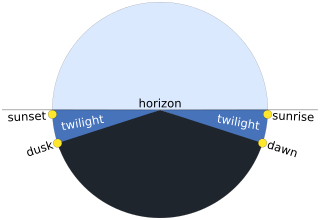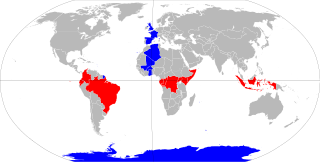Related Research Articles

In astronomy, declination is one of the two angles that locate a point on the celestial sphere in the equatorial coordinate system, the other being hour angle. The declination angle is measured north (positive) or south (negative) of the celestial equator, along the hour circle passing through the point in question.
A solar equinox is a moment in time when the Sun crosses the Earth's equator, which is to say, appears directly above the equator, rather than north or south of the equator. On the day of the equinox, the Sun appears to rise "due east" and set "due west". This occurs twice each year, around 20 March and 23 September.

The Northern Hemisphere is the half of Earth that is north of the Equator. For other planets in the Solar System, north is defined as being in the same celestial hemisphere relative to the invariable plane of the Solar System as Earth's North Pole.
A solstice is an event that occurs when the Sun reaches its most northerly or southerly excursion relative to the celestial equator on the celestial sphere. Two solstices occur annually, around June 21 and December 21. In many countries, the seasons of the year are determined by the solstices and the equinoxes.

The Tropic of Cancer, also known as the Northern Tropic, is the northernmost circle of latitude on Earth at which the Sun can be seen directly overhead. This occurs on the June solstice, when the Northern Hemisphere is tilted toward the Sun to its maximum extent. It also reaches 90 degrees below the horizon at solar midnight on the December Solstice. Using a continuously updated formula, the circle is currently 23°26′10.1″ (or 23.43613°) north of the Equator.

The Tropic of Capricorn is the circle of latitude that contains the subsolar point at the December solstice. It is thus the southernmost latitude where the Sun can be seen directly overhead. It also reaches 90 degrees below the horizon at solar midnight on the June Solstice. Its northern equivalent is the Tropic of Cancer.

A circle of latitude or line of latitude on Earth is an abstract east–west small circle connecting all locations around Earth at a given latitude coordinate line.

Solar time is a calculation of the passage of time based on the position of the Sun in the sky. The fundamental unit of solar time is the day, based on the synodic rotation period. Traditionally, there are three types of time reckoning based on astronomical observations: apparent solar time and mean solar time, and sidereal time, which is based on the apparent motions of stars other than the Sun.

Noon is 12 o'clock in the daytime. It is written as 12 noon, 12:00 m., 12 p.m., 12 pm, or 12:00 or 1200 . Solar noon is the time when the Sun appears to contact the local celestial meridian. This is when the Sun reaches its apparent highest point in the sky, at 12 noon apparent solar time and can be observed using a sundial. The local or clock time of solar noon depends on the date, longitude, and time zone, with Daylight Saving Time tending to place solar noon closer to 1:00pm.

The thermal equator is a belt encircling Earth, defined by the set of locations having the highest mean annual temperature at each longitude around the globe. Because local temperatures are sensitive to the geography of a region, mountain ranges and ocean currents ensure that smooth temperature gradients are impossible, the location of the thermal equator is not identical to that of the geographic Equator.

Twilight is light produced by sunlight scattering in the upper atmosphere, when the Sun is below the horizon, which illuminates the lower atmosphere and the Earth's surface. The word twilight can also refer to the periods of time when this illumination occurs.

A transit of Deimos across the Sun as seen from Mars occurs when Deimos passes directly between the Sun and a point on the surface of Mars, obscuring a small part of the Sun's disc for an observer on Mars. During a transit, Deimos can be seen from Mars as a small dark spot rapidly moving across the Sun's face.

The subsolar point on a planet is the point at which its Sun is perceived to be directly overhead ; that is, where the Sun's rays strike the planet exactly perpendicular to its surface. It can also mean the point closest to the Sun on an astronomical object, even though the Sun might not be visible.
Mahalapye is a town located in the Central District of Botswana. The town has about 41,000 inhabitants and is situated along the main road between the capital Gaborone and the second largest city Francistown. Mahalapye has a bus station, a railway station, a couple of hotels and a market area with many shops and fast food restaurants, Water Shed mall is the latest attraction to those travelling from Gaborone to Francistown, great place for refreshments. It also has several petrol stations, some open 24 hours per day. Being situated on the edge of the Kalahari desert it is quite dry, and the local waterways are dry except during the rainy season. In recent times, it has become a convenient stop-over town for travelers travelling to and from Gaborone.

Maghe Sankranti is a Nepali festival observed on the first of Magh in the Vikram Sambat (B.S) or Yele calendar bringing an end to the winter solstice containing month of Poush. Tharu people celebrate this particular day as new year. It is also regarded as the major government declared annual festival of the Magar community. Maghe Sankranti is similar to solstice festivals in other religious traditions.

The five main latitude regions of Earth's surface comprise geographical zones, divided by the major circles of latitude. The differences between them relate to climate. They are as follows:
- The North Frigid Zone, between the North Pole at 90° N and the Arctic Circle at 66°33′49.9″ N, covers 4.12% of Earth's surface.
- The North Temperate Zone, between the Arctic Circle at 66°33′49.9″ N and the Tropic of Cancer at 23°26′10.1″ N, covers 25.99% of Earth's surface.
- The Torrid Zone, between the Tropic of Cancer at 23°26′10.1″ N and the Tropic of Capricorn at 23°26′10.1″ S, covers 39.78% of Earth's surface.
- The South Temperate Zone, between the Tropic of Capricorn at 23°26′10.1″ S and the Antarctic Circle at 66°33′49.9″ S, covers 25.99% of Earth's surface.
- The South Frigid Zone, from the Antarctic Circle at 66°33′49.9″ S and the South Pole at 90° S, covers 4.12% of Earth's surface.

Daytime as observed on Earth is the period of the day during which a given location experiences natural illumination from direct sunlight. Daytime occurs when the Sun appears above the local horizon, that is, anywhere on the globe's hemisphere facing the Sun. In direct sunlight the movement of the sun can be recorded and observed using a sundial that casts a shadow that slowly moves during the day. Other planets and natural satellites that rotate relative to a luminous primary body, such as a local star, also experience daytime, but this article primarily discusses daytime on Earth.

Sun path, sometimes also called day arc, refers to the daily and seasonal arc-like path that the Sun appears to follow across the sky as the Earth rotates and orbits the Sun. The Sun's path affects the length of daytime experienced and amount of daylight received along a certain latitude during a given season.

The equator is a circle of latitude that divides a spheroid, such as Earth, into the Northern and Southern hemispheres. On Earth, the Equator is an imaginary line located at 0 degrees latitude, about 40,075 km (24,901 mi) in circumference, halfway between the North and South poles. The term can also be used for any other celestial body that is roughly spherical.
A season is a division of the year based on changes in weather, ecology, and the number of daylight hours in a given region. On Earth, seasons are the result of the axial parallelism of Earth's tilted orbit around the Sun. In temperate and polar regions, the seasons are marked by changes in the intensity of sunlight that reaches the Earth's surface, variations of which may cause animals to undergo hibernation or to migrate, and plants to be dormant. Various cultures define the number and nature of seasons based on regional variations, and as such there are a number of both modern and historical cultures whose number of seasons varies.
References
- ↑ "Climate and Currents" . Retrieved 4 March 2011.
- ↑ "What Is a Solstice? | NOAA SciJinks – All About Weather".